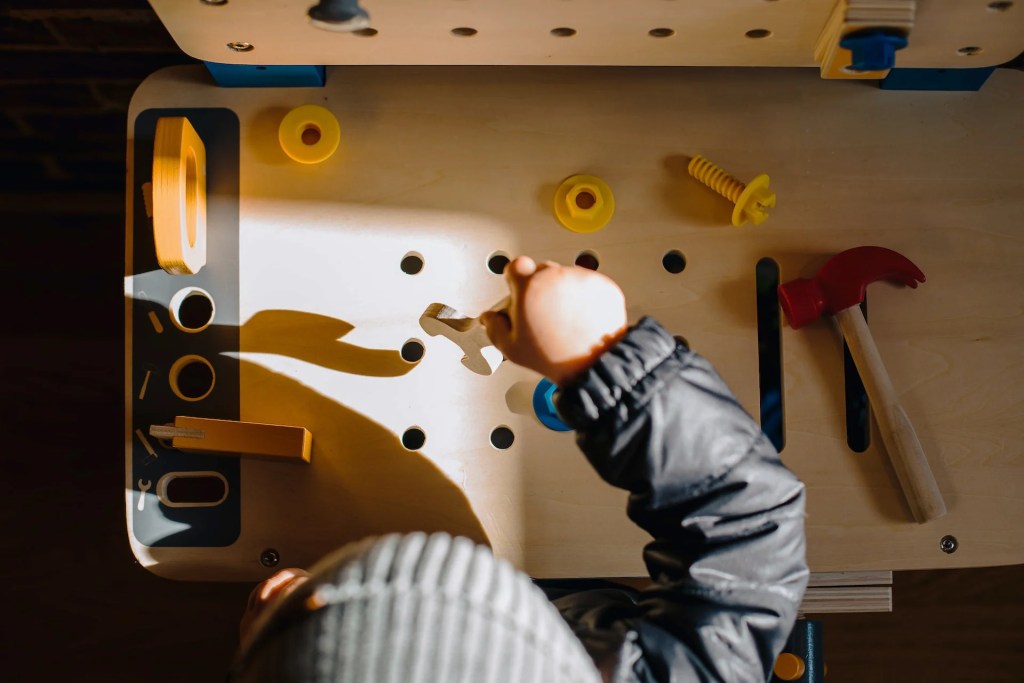6 Things to Say to Your Child, Now and Always
Besides “I love you”, what else does your child need to hear from you?
- What you think and feel is important to me.
- We can both do hard things.
- Sometimes we do what we want to do, sometimes we do what we have to do.
- I want to hear what you have to say. I’m listening.
- My feelings are mine. I am in charge of them and it’s up to me to manage them.
- Sometimes I am angry with you, and sometimes you are angry with me. And that’s okay.
Successful parenting requires you to have many “tools” in your parenting “toolbox” and here I will discuss 3 BIG ones. These aren’t your only tools, but they’re essential:
- Validating Emotions
- Setting Boundaries
- Encouraging Coping Skills

Validating Emotions
Validation is one of the best forms of emotional support you can offer your child (or anyone).
Validating your child’s feelings IS NOT:
- Trying to change, fix, or undo how they feel
- Minimizing how they feel
Validating your child’s feelings IS:
- Naming and acknowledging your child’s feelings
- Reflecting back to them how they feel (almost as if you were a mirror)
- Normalizing that it’s okay to feel emotions
Let’s look at EXAMPLES!
- “I hear you” Instead of “Why would you say that!?”
- “What I’m hearing is that you were feeling really disappointed.” Instead of “Oh, don’t be disappointed! It’s not a big deal.”
- “Yeah, that does sound hard. I get that.” Instead of “Don’t worry! I’ll take care of it and fix this.”
- “Yeah, that does sound hard. I get that.” Instead of “Don’t worry! I’ll take care of it and fix this.”
- “I understand.” Instead of “Enough crying already.”
Here’s one more example:
“Sounds like you’re feeling really frustrated that you didn’t get what you wanted. I know what that feels like. It doesn’t feel good.”
Notice in these examples you’re not trying to change how your child is feeling and you’re not asking a lot of questions. You are reflecting back to your child how they feel in an effort to encourage emotional awareness and eventual emotional ownership and regulation…big, big life skills! You can and should start this early with your young toddlers.
Validation is not your only tool, but it’s often the 1st tool you can use when responding to your child’s emotions. It’s a way to connect and begin to calm things down so that you can then start to employ your other tools.
You know that feeling when you are having a hard time and you vent or confide in someone and then feel really heard and seen by them? Feels so good, right? You begin to let your guard down, feel a little more relaxed, and become more open to communication and input. That’s the power of validation.
Validating your child’s feelings does not mean you agree with how they feel. It just means you are recognizing how they feel. Your child spilled their drink and they’re now crying. You know this is “not a big deal” based on your knowledge, perspective, and life experience. Validating your child in this scenario can sound something like: “I see you’re upset, sweetie.”
Notice that you’re acknowledging that they are upset because their drink spilled. You’re validating your child’s subjective experience, even if you don’t necessarily agree with it.
DON’T FORGET: Parents, don’t forget to validate your own emotionsas well. Here’s what that can sound like:
- “Wow, this is challenging.”
- “I’m really having a hard time right now… I feel pulled in so many directions.” “This is tough… I also know I can do it.”
- “This feels like a lot…like it’s all on me…I know that’s not always true… but that’s how it feels right now.”
You are the foundation. Don’t forget to show yourself the same patience and understanding you show your child.

Setting Boundaries
What is a boundary? Put simply, a boundary is a parameter or guideline for your child’s behavior. You set boundaries to behaviors (an important distinction) and not to emotions.
Behaviors are outward displays of emotions. The internal and invisible emotions that we feel inside cause our external, visible behaviors. If your child is feeling mad (emotion) they may…hit or kick you (behavior). If your child is feeling disappointed (emotion) they may scream (behavior). In the same way, if your child is feeling happy (emotion) they may jump around and laugh (behaviors).
You set boundaries to your child’s behaviors (for example, kicking or screaming) and NOT to the underlying emotion that is causing the behavior (for example, feeling disappointed or angry). Essentially, it’s okay to feel mad… not okay to kick someone when you’re mad.
Here’s what this can sound like: “Whoa, you’re angry… it’s OK to feel angry, but you CANNOT kick me when you’re angry. What can you do when you’re angry? You can…”

Healthy Boundaries, Respect, and Consistency
Boundaries are created and enforced for the emotional and physical well-being of your child. Trust in yourself as a parent. You have years of experience, insight, and the ability to understand long-term consequences and you use those abilities to mentor your child.
Respecting your child does not mean you accept all their behaviors or they agree with all your boundaries. Respecting your child means you respect the person your child is while guiding their behavior and holding your boundaries, even in the face of their protest.
Appropriate boundaries take into account your child’s abilities, age, and developmental stage. For example, it’s not reasonable to expect a toddler to sit still for long periods of time. It’s not reasonable to expect a young child to never feel frustrated when you say no to something. It’s not reasonable to expect your tween to share every secret with you.
It’s incredibly helpful to have a basic understanding of your child’s development and what’s considered typical. This enables you to have a balanced perspective and to create realistic boundaries that your child will be able to respond to.
Consistency is key. It’s also the hardest part of maintaining boundaries for many parents. Unfortunately, there’s no magic trick here and your consistency in holding boundaries truly is important.
Try your best. You don’t have to be perfect, you really don’t. Still, you do need to try your best, even in the face of challenges.

Clear Communication
What’s the use of a boundary that no one knows about or understands? Once you have decided what your boundaries are going to be, have a calm conversation with your child/family about them.
Communicate clearly and directly using precise and detailed language. “I’ve been thinking… you know how recently you have been… saying/doing… and then I have been saying/doing… It hasn’t really been working for us and we’re going to be trying something different. From now on, when you… I will respond like this…and I will remind you and we will keep practicing, together”

Stay Calm
I know it’s hard, I really do…but don’t add your own emotions to an already emotional situation. Your boundary is not meant to punish or make your child “feel bad” for what they have done. Your boundary is meant to guide your child. You can’t be a guide and mentor to your child if you’re not in control of your own emotions. Your child is impulsive, irrational, intense… you are not. Do your best to stay as calm as you can.
Examples:
- “You are sounding really frustrated. You can feel frustrated but you cannot talk to me like that when you’re frustrated. Take a breath if you need to and try again.”
- “When we leave the house you will hold my hand. You might want to let go and run off, and I will not let that happen. You might cry… that’s ok. We will hold hands while we walk.”
- “TV is turning off in 5 minutes… letting you know you may whine, get upset, not want to… that’s ok, sweetie. TV will still be turned off.” “That was your last cookie. I have a feeling you’re thinking if you keep asking me I may change my mind… I won’t sweetie. No more cookies.”
- “I know you want that toy… I hear you loud and clear. No, we’re not getting it. I’m sorry you’re disappointed.”
- “Whoa, can’t throw that truck. You are great at throwing! What can you throw? A ball, that’s right. No throwing the truck. Looks like we can’t use this truck right now. That’s okay, we can try again later.”
- “NO hitting me. You’re angry… that’s ok. You cannot hit me when you are angry. You can tell me: I am SO ANGRY at you! And I will say: Okay, I understand… But, you cannot hit me.”
- “Wow, you love splashing 🙂 No splashing water outside the bathtub. Where can you splash? Yes… inside the tub, that’s right. Like this! Cannot splash outside the tub.”
Notice in all the examples, that you’re being very precise and direct. Statements like “Don’t do that!” or “Stop!” are too general. Instead, provide exact guidance in your boundary for what behavior is not okay (and ideally an alternative for what IS okay.)
When I talk to parents about boundaries one of the main sources of frustration I hear about comes from consistency… or lack of consistency. It’s very difficult to hold a boundary consistently all the time.
A HELPFUL TIP: Have a plan! During a calm moment (and not in the heat of the moment) come up with your plan. Decide what boundaries are most important for you to uphold, and decide how you want to respond to them. Memorize your “script”, your response, and even your body language, and phrasing.
Having a thought-through plan eliminates the guesswork in the heat of the moment and, therefore, really helps you respond consistently and calmly (and with much less guilt). And if you’re not 100% consistent every time… will all your hard work disappear? No, it absolutely won’t. Try your best, believe in yourself, and have patience for your child and for yourself.

Be Realistic
Will you have to repeat your boundary more than once to your child? Of course! Possibly over and over again? Yes.
Remind yourself as many times as you need that your child is learning, growing, maturing, practicing their new skills, and most certainly…pushing back. That’s okay… that’s actually what they’re supposed to do.

Final Note on Boundaries
Your child doesn’t have to agree with your boundaries. In fact, they likely won’t. You determine the boundaries because you are the parent, you have knowledge and experience and you make decisions with your child’s best interest in mind.
Meanwhile, your child decides how they want to feel about your boundaries (angry/upset/frustrated) and that is totally okay. Expect a protest, and still, calmly hold your boundary, trusting in yourself.

Coping Skills
An essential “tool” in your parenting “toolbox” is encouraging your child to develop and trust in THEIR OWN natural ability to cope and manage for themselves. This can often feel very challenging for parents because it involves you not jumping in to fix, solve, distract, or take away your child’s difficult emotions.
That means you have to be okay with your child “sitting” in their uncomfortable feelings and managing through them…which, of course, can be hard for any parent.
Think about it this way: Your child cannot find their strength, build their resilience, and learn to solve their problems if you don’t give them the opportunity to try. Yes, it may feel uncomfortable in the moment, but the lifelong skills they’re learning are worth it.
Okay, so if you’re not fixing, then what are you doing…?
Let’s look at some examples:
- “I know sweetie, sometimes things don’t work out how we want them to… (pause…) What would you like to do now?“
- “I hear you…what do you think you can do to help yourself feel a little bit better? If you think I can help you, can you tell me what type of help you need?”
- “You’re right…this is hard! Let’s breathe…maybe take a break. Then you can try again.”
- “Take your time to be upset. When you’re ready, let me know what you want to do next.”
- “Do you think you will feel upset for a short time or a long time? It’s up to you.”
- “I know this doesn’t feel good… Do you have any ideas for how you can help yourself feel a little better? I have some…and I’d love to hear yours.”
What you’re doing is allowing the space for your child to sit with their feelings and begin to understand that their feelings are actually up TO THEM to solve, and not up to you to solve. THEY have the ultimate choice in how they feel and THEY have the power to decide what they want to do about their feelings.
*Can you offer suggestions? *
Yes, of course! Just recognize that it’s helpful to first give your child the opportunity to help themselves before you jump in and solve. Think that with a lot of practice and trial and error, your ultimate goal is for your child to (eventually) be able to manage, cope, and contain their emotions on their own, without relying on you.

I DON’T KNOW!
So, you ask your child what they want to do…or how they want to help themselves and they say: “I don’t know!” That’s okay! It takes time to know what to do… and you can tell them that. “That’s ok, sweetie… take your time to think about it. It takes time to know what to do…we can talk about it again soon.”
And what if your child’s idea is that you give them what they want…you solve their problem for them…you give them what you already said you wouldn’t? “Hmm…that’s one idea… sometimes we can do that. Not right now. I bet you can think of another idea.”
This takes time, patience, and practice, no doubt about that. You can do it! And you want to believe that you can.

The Role of a Parent
How do you view your role as a parent?
- Your role is NOT to rule over your child. Your role IS to guide your child.
- Your role is NOT to scare your child into submission. Your role IS to keep your child safe.
- Your role is NOT to demand obedience. Your role IS to encourage cooperation.
- Your role is NOT to make your child happy. Your role IS to accept all of your child’s emotions.
- Your role is NOT to shield your child from problems. Your role IS to guide your child to problem-solve.
Parenting is not easy, no doubt about that. But that doesn’t mean it has to feel so overwhelming! My goal is to make your parenting journey:
- Less guilty
- Less stressful
- Less overwhelming
And, most of all, I want to help you increase the connection between you and your child. How? With:
- Precise scripts
- Practical tools
- Strategies that actually work
- Real-life examples to model
Want more? Check out Dr. Siggie’s online parenting courses.










